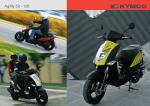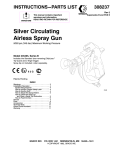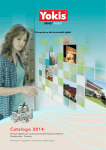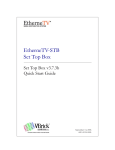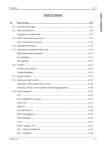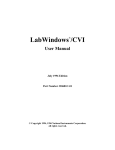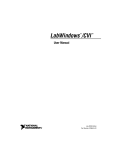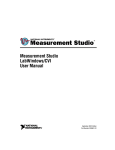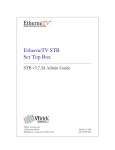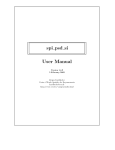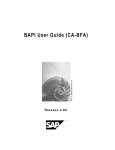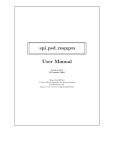Download LabWindows/CVI Release Notes Version 5.5
Transcript
RELEASE NOTES LABWINDOWS/CVI™ RELEASE NOTES Version 5.5 These release notes contain system requirements, installation instructions, new features, and updated information to help you begin using LabWindows/CVI 5.5. Contents LabWindows/CVI Installation ................................................................ 3 Minimum System Requirements ..................................................... 3 Installing LabWindows/CVI............................................................ 4 Before Installation .................................................................... 4 Running the Installation............................................................ 4 After Installation....................................................................... 5 What’s New and Different in LabWindows/CVI 5.5 ............................. 6 Overview of New Features .............................................................. 6 New Sample Programs..................................................................... 6 ActiveX Samples ...................................................................... 6 Application Samples................................................................. 7 Custom Control Samples .......................................................... 7 DataSocket and OPC through DataSocket Samples................. 7 Dynamic Link Library (DLL) Samples .................................... 7 Multithreading Samples............................................................ 7 Programmer’s Toolbox Samples .............................................. 7 Report Generation Samples ...................................................... 7 Serial Communication Samples................................................ 7 User Interface Samples ............................................................. 8 Windows SDK Samples ........................................................... 8 Source Code Control Integration ..................................................... 8 ActiveX Automation Controller ...................................................... 8 Instrument Drivers .................................................................... 8 Support for Events .................................................................... 8 Support For Multithreading ...................................................... 8 Dual Interface Support.............................................................. 9 ActiveX Automation Controller Wizard .................................. 9 Per-Object Property Get and Set Functions.............................. 9 CVI™, National Instruments™, ni.com™, NI-488.2™, NI-DAQ™, NI-VISA™, and NI-VXI™ are trademarks of National Instruments Corporation. Product and company names are trademarks or trade names of their respective companies. 320689F-01 © Copyright 1999, 2000 National Instruments Corp. All rights reserved. February 2000 New ActiveX Automation Library Functions ...........................9 User Interface Enhancements ...........................................................10 Table Control.............................................................................10 UIR Localization Utility............................................................10 UIConv Utility...........................................................................10 Multiple Monitor Support .........................................................11 Localized Decimal Symbol Support .........................................11 Graph Legend Custom Control .................................................11 Combo Box Custom Control.....................................................11 Other User Interface Enhancements..........................................11 New User Interface Library Functions......................................11 New User Interface Library Attributes......................................13 Automation Server Enhancements ...................................................14 New Methods ............................................................................14 Compiler/Linker/Debugger/Build Changes and Enhancements ......15 Debuggable DLLs .....................................................................15 Multithreaded Debugging .........................................................15 DataTips For Variables and Expressions ..................................15 Visual C++ 6.0 Import Libraries ...............................................15 Borland C++ Builder 4.0...........................................................15 Build States When Unloading and Reloading a Project............16 Debug and Release Configurations ...........................................16 Run-Time Checking in Debuggable DLLs ...............................16 User Program Windows ............................................................16 Debug Output Window and Run-Time Error Window.............16 Standard I/O Window................................................................17 Go To Definition Command .....................................................17 Hidden Environment Windows .................................................17 Change in Behavior of Ctrl-F12................................................17 Run State Change Callbacks .....................................................17 Instrument Driver Support Only ...............................................18 Target Settings Dialog Box .......................................................18 Threads Dialog Box ..................................................................18 Changes to Run Options Dialog Box ........................................18 Changes to Compiler Options Dialog Box................................18 Changes to Environment Dialog Box........................................18 Memory Display Window.........................................................18 Force Include of SDK Import Libraries ....................................19 Pop-up Menu in Build Error Window.......................................19 Build Utility...............................................................................19 Set Breakpoints While Program Is Running .............................19 Update Windows when Suspending..........................................19 Function Panel Changes and Enhancements ....................................19 Function Panel Format ..............................................................19 Utility Library Changes and Enhancements.....................................20 Multithreaded Utilities ..............................................................20 LabWindows/CVI Release Notes 2 www.ni.com LoadExternalModule in LabWindows/CVI ............................. 20 Loading Source Files Using LoadExternalModule .................. 21 New Utility Library Functions ................................................. 21 New DataSocket Library ................................................................. 23 New RS-232 Library Functions ....................................................... 24 New Advanced Analysis Functions ................................................. 25 Toolslib Changes and Enhancements .............................................. 25 Toolslib Instrument Drivers Multithreaded Safety................... 25 New Toolbox Functions ........................................................... 25 Additional Enhancements ................................................................ 28 Report Generation..................................................................... 28 Console Applications Support .................................................. 28 Run-Time Engine and Windows Shutdown ............................. 28 Updated Windows SDK ........................................................... 29 Formatting and I/O Library Fmt/FmtOut/FmtFile Functions... 29 Changes to the LabWindows/CVI User Manual..................................... 29 Chapter 3—Project Window............................................................ 29 Build Menu ............................................................................... 29 Tools Menu............................................................................... 29 Help Menu ................................................................................ 30 Options Menu ........................................................................... 31 Windows Menu......................................................................... 31 Changes to the LabWindows/CVI Programmer Reference Manual ....... 32 Chapter 4—Creating and Distributing Standalone Executables and DLLs ..................................................................... 32 LabWindows/CVI Installation The following sections include information on system requirements and installation of LabWindows/CVI 5.5. Minimum System Requirements To run LabWindows/CVI, you must have the following: • Personal computer using a Pentium 90 or higher microprocessor • Windows 2000, Windows NT 4.0 Service Pack 3, Windows 98, or Windows 95 • 800 by 600 resolution (or higher) video adapter • Minimum of 16 MB of RAM • 50 MB free hard disk space • Microsoft-compatible mouse © National Instruments Corporation 3 LabWindows/CVI Release Notes Installing LabWindows/CVI National Instruments suggests that you install the complete LabWindows/CVI 5.5 program to take full advantage of all LabWindows/CVI 5.5 capabilities. If you choose to install with options, select the options you want and follow the onscreen directions. If necessary, you can run the setup program again and install additional files. Before Installation • Install Internet Explore 4.0.1 or later in order to access the Windows Software Developers Kit (SDK) Help. You can download Internet Explorer from Microsoft’s web site at http://www.microsoft.com. • Choose the Custom Installation option to install the complete Windows SDK from the CD-ROM version of the LabWindows/CVI Full Development System (FDS). Some Windows SDK header and import library files are included when you install the LabWindows/CVI Base Package. The Windows SDK help file is available only with the LabWindows/CVI FDS. • Be aware that the LabWindows/CVI installation includes the LabWindows/CVI 5.5 Run-time Engine for Windows. This version overwrites previous versions of the run-time engine. Thus, LabWindows/CVI 4.x, 5.0, and 5.01-generated executables and DLLs use the new LabWindows/CVI 5.5 Run-time Engine. In addition, the LabWindows/CVI 4.x, 5.0, and 5.0.1 Create Distribution Kit feature includes, in generated distribution kits, the LabWindows/CVI 5.5 Run-time Engine instead of the LabWindows/CVI 4.x, 5.0, and 5.0.1 Run-time Engine. • Use TestStand 1.0.1 if you want to use LabWindows/CVI 5.5 with TestStand. TestStand 1.0.1 is a free update to TestStand 1.0. Go to http://www.ni.com/teststand for instructions and more information on TestStand 1.0.1. Running the Installation If you have a previous version of LabWindows/CVI, be sure to install this version in a different directory or uninstall the older version before installing this version. Perform the following steps to install LabWindows/CVI: 1. Insert the Measurement Studio Installation CD into the CD-ROM drive. 2. After a few seconds, a dialog box appears. If the dialog box does not appear, click on Windows Start»Run and type d:\setup.exe in the Open text box, where d is your CD-ROM drive. 3. When the Measurement Studio Installation CD dialog box appears, click on the View Readme option to the right of the Install LabWindows/CVI option. 4. After reading and closing the Readme file, choose Install LabWindows/CVI from the Measurement Studio Installation CD dialog box and follow the onscreen instructions. LabWindows/CVI Release Notes 4 www.ni.com After Installation • Choosing a Compatible Compiler—When you install LabWindows/CVI, you must choose a compatible compiler. If you want to change your choice later, run the installation program again and select the option that allows you to choose a new compatible compiler. • Using NI-VISA and the IVI Engine—The LabWindows/CVI installation includes NI-VISA and the IVI Engine. You must have the Virtual Instrument Software Architecture (VISA) Library to use the new instrument driver standard that the VXIplug&play Systems Alliance accepts. You must have the Interchangeable Virtual Instruments (IVI) Engine to use IVI drivers on a system. • Making Backup .uir Files—If you have been using LabWindows/CVI 4.0.1 or earlier, you should make backup copies of your.uir files. Once .uir files have been saved in version 5.5, they are partially compatible with versions 4.0.1, 3.1 and 3.0.1. You can load them, but if you save them in the previous versions you lose the new 5.5 features. Once the.uir files have been saved in version 5.5, they are no longer compatible with version 3.0. • Using GPIB, VXI, DAQ, or VISA—If you plan to use GPIB, VXI, DAQ, or VISA with LabWindows/CVI, you must have a compatible driver from National Instruments. • Installing LabWindows/CVI in a New Directory—If you already installed the NI-DAQ software for a previous version of LabWindows/CVI and you are installing this version of LabWindows/CVI in a new directory, you must reinstall the CVI portion of the NI-DAQ software into the new CVI directory. • Installing NI-DAQ 6.6 and GPIB 1.6—The National Instruments hardware and software drivers for NI-DAQ 6.6 amd GPIB 1.6 are included on the CD-ROM version of the LabWindows/CVI in the \Drivers\ subdirectory. • Using GPIB—If you plan to use GPIB with LabWindows/CVI, you must have a 488.2-compatible GPIB board from National Instruments. You also must have installed the NI-488.2 software for Windows 95 or Windows NT. • Using the Data Acquisition Library—If you plan to use the Data Acquisition library with LabWindows/CVI, you must have a data acquisition board from National Instruments. • Installing NI-DAQ Software—You must install the NI-DAQ software from the distribution diskettes for NI-DAQ version 4.9.0 or later. NI-DAQ 6.6 is included on the CD-ROM version of LabWindows/CVI. • Using the NI-VXI Library—If you plan to use the NI-VXI library with LabWindows/CVI, you must have installed the NI-VXI Software Interface drivers. Please contact National Instruments for more information. • Converting LabWindows/DOS Programs—If you want to convert LabWindows/DOS programs to run under LabWindows/CVI, read Chapter 12, Converting LabWindows for DOS Applications, in the Getting Started with LabWindows/CVI manual. © National Instruments Corporation 5 LabWindows/CVI Release Notes Note Refer to the readme.cvi file for installation instructions, programming considerations, and changes that are too recent to be included in the LabWindows/CVI 5.5 documentation, help files, and release notes. What’s New and Different in LabWindows/CVI 5.5 This document does not contain detailed information on all changes to LabWindows/CVI 5.5. Please refer to the manual set for additional information on changes to the program. This section includes information about changes and enhancements in LabWindows/CVI 5.5 that have been made since LabWindows/CVI 5.0. Overview of New Features LabWindows/CVI 5.5 includes the following new features: • Source Code Control Integration • Ability to debug multithreaded programs • Events and Dual Interface support in ActiveX Automation controllers • Ability to debug DLLs with full run-time checking • Table Control • User Interface Localization Utility • Support for multiple monitor systems • Report generation • Ability to create Console applications • DataTips to view variables and expressions while debugging • Compatibility with Borland C++ Builder 4.0 • Updated Windows SDK • DataSocket Library for networking • Additional functions or features added to RS-232, Utility, and Formatting and I/O Libraries • Additional Hilbert Transform and error calculation functions New Sample Programs LabWindows/CVI 5.5 includes the following sample programs: ActiveX Samples samples\activex\excel\excelevents97.prj samples\activex\excel\excelevents2000.prj samples\activex\matlab\matlabdemo.prj LabWindows/CVI Release Notes 6 www.ni.com samples\activex\outlook\outlookrep97.prj samples\activex\outlook\outlookrep2000.prj samples\activex\powerpoint\simple.prj samples\activex\word\wordrpt.prj Application Samples samples\apps\finger\finger.prj samples\apps\localui\intgraph.prj samples\apps\tankdemo\tank.prj Custom Control Samples samples\userint\custctrl\combobox\combodemo.prj samples\userint\custctrl\legend\lgdemo.prj DataSocket and OPC through DataSocket Samples samples\datasocket\*.* Dynamic Link Library (DLL) Samples samples\dll\gui\guidll.prj samples\dll\gui\useguidll.prj Multithreading Samples samples\apps\daqmthread\daqMT.prj samples\utility\threading\*.* Programmer’s Toolbox Samples samples\toolbox\msgdemo.prj samples\toolbox\trayicon.prj Report Generation Samples samples\reportgen\nirsample.prj samples\activex\word\wordrpt.prj Serial Communication Samples samples\rs232\commcallback.prj © National Instruments Corporation 7 LabWindows/CVI Release Notes User Interface Samples samples\userint\colview.prj samples\userint\gridview.prj samples\userint\multimonitor.prj samples\userint\splash.prj Windows SDK Samples samples\sdk\audio\cdplayer.prj Source Code Control Integration You can integrate a third-party source code control provider with the LabWindows/CVI 5.5 environment, and then interface with your source code control provider from LabWindows/CVI 5.5. Select Options»Source Code Control Options in the Project window to configure LabWindows/CVI 5.5 to work with your provider. Use the commands in Tools»Source Code Control to perform common source code control actions. Errors and warnings generated by source code control commands appear in the Source Code Control Error window. ActiveX Automation Controller This section describes ActiveX Automation changes and enhancements in LabWindows/CVI. Instrument Drivers To support the new features in ActiveX Automation Controller instrument drivers, the drivers generated by LabWindows/CVI 5.5 differ from the drivers generated by LabWindows/CVI 5.0.1. If you need to regenerate an ActiveX Automation controller instrument driver, and want to minimize the changes to the driver functions, select Per Server in the Property Access Functions control in the ActiveX Automation Controller Wizard. Support for Events Some ActiveX Automation server objects generate events in addition to providing methods for you to call from an ActiveX Automation client program. LabWindows/CVI 5.5 generates code in ActiveX Automation controller instrument drivers that allows you to receive events. LabWindows/CVI 5.5 generates callback registration functions that allow you to specify a callback that is called when the server generates a specific event. Support For Multithreading You can now safely use an ActiveX Automation handle across threads, regardless of the threading model of the threads, if you pass TRUE in the Support Multithreading parameter in the object creation functions. LabWindows/CVI Release Notes 8 www.ni.com Dual Interface Support Some ActiveX Automation servers support an alternate method of accessing functions and properties through dual interfaces. LabWindows/CVI 5.5 can generate ActiveX Automation Controller instrument drivers that use dual interfaces to access the server more efficiently. You can select this option when you use the ActiveX Automation Controller Wizard. ActiveX Automation Controller Wizard You can use this wizard to create an instrument driver to control an ActiveX Automation Server. The ActiveX Automation Controller Wizard includes support for ActiveX Automation Events as well as dual interfaces. The ActiveX Automation Controller Wizard is located in the Tools menu. Per-Object Property Get and Set Functions The ActiveX Automation Controller generated in LabWindows/CVI 5.0.1 contained a single set of property get and set functions for each ActiveX Automation Controller. In LabWindows/CVI 5.5, you can choose to generate property get and set functions for each object in the controller. If you choose to generate per-object property get and set functions, you must use the appropriate property get and set functions to access properties for a particular object. New ActiveX Automation Library Functions Free BSTR CA_FreeBSTR Fill Error Info CA_FillErrorInfo Init ActiveX Thread Style For Current Thread CA_InitActiveXThreadStyleForCurrentThread Set Support For Multithreading CA_SetSupportForMultithreading Get Support For Multithreading CA_GetSupportForMultithreading Get Active Object By Class ID CA_GetActiveObjectByClassIdEx Get Active Object By Prog ID CA_GetActiveObjectByProgIdEx Create Object By Class ID CA_CreateObjectByClassIdEx Create Object By Prog ID CA_CreateObjectByProgIdEx Load Object From File CA_LoadObjectFromFileEx Load Object From File By Cls ID CA_LoadObjectFromFileByClassIdEx Load Object From File By Prog ID CA_LoadObjectFromFileByProgIdEx © National Instruments Corporation 9 LabWindows/CVI Release Notes Create ObjHandle from Interface CA_CreateObjHandleFromInterface Register Event Callback CA_RegisterEventCallback Unregister Event Callback CA_UnregisterEventCallback Unregister All Event Callbacks CA_UnregisterAllEventCallback Enable Events For Server Object CA_EnableEventsForServerObject Get Event Callback CA_GetEventCallback Safe Array to 1D Array CA_SafeArrayTo1DArrayEx Safe Array to 2D Array CA_SafeArrayTo2DArrayEx Safe Array to 1D Array Buffer CA_SafeArrayTo1DArrayBufEx Safe Array to 2D Array Buffer CA_SafeArrayTo2DarrayBufEx Duplicate ObjHandle CA_DuplicateObjHandle User Interface Enhancements This section describes the user interface enhancements in LabWindows/CVI. Table Control You can create a table control in your graphical user interface. A table control can contain string, numeric, and picture cells. The user interface library contains functions to create and manipulate a table control. Refer to LabWindows/CVI Online help for more information on using a table control. UIR Localization Utility You can use the Localization utility to easily translate your user interface resource files. To access this utility, choose Tools»User Interface Localizer. You can then use the LoadLocalizedPanel and LoadLocalizedMenu functions—located in the CVI\toolslib\localui\localui.fp function panel file—to load the translated panels and menu bars. UIConv Utility UIConv is a utility that reads the contents of .tui files and generates code to build the user interface programmatically, eliminating the need to distribute a separate .uir file with your LabWindows/CVI 5.5 application. To access this utility, choose the Utility Programs submenu of the Measurement Studio Group in the Start menu of the Windows taskbar. A .tui file is a text version of a .uir file. To generate a .tui file, open a .uir file in the User Interface Editor and then choose Options»Save in Text Format. LabWindows/CVI Release Notes 10 www.ni.com Multiple Monitor Support CVI supports multiple monitors. Features in the environment such as windows, dialog boxes, and menus behave in an appropriate manner on a multiple monitor system. You also can use the functions in the user interface library to iterate through all the monitors, get monitor attributes such as coordinates and color depth, and set the default monitor for your application. Windows 98 and Windows 2000 support multiple monitors. Localized Decimal Symbol Support You can configure the User Interface Editor to use the operating system's decimal symbol as follows. Access the Editor Preferences dialog box in the Options»Preference in the User Interface Editor and select the Use localized decimal symbol checkbox. To make your program use the system’s decimal symbol, make the following function call: SetSystemAttribute(ATTR_USE_LOCALIZED_DECIMAL_SYMBOL, VAL_USE_SYSTEM_SETTING) Graph Legend Custom Control The sample program samples\userint\custctrl\lg_demo.prj contains a graph legend control instrument driver. Combo Box Custom Control The sample program samples\userint\custctrl\combobox.prj contains a combo box control instrument driver. Other User Interface Enhancements • The IDs for message controls and other indicator controls now remain stable when you edit them in the User Interface Editor. • The number of lines in a Listbox or Textbox is now limited only by available memory. • The number of Graph cursors is now limited only by available memory. • The Edit Tab Order dialog box is now sized to display the entire panel, if the dialog box fits on your screen. Additional attributes and functions are listed in the following sections. New User Interface Library Functions This section lists the new User Interface Library functions in LabWindows/CVI 5.5. © National Instruments Corporation 11 LabWindows/CVI Release Notes Table Control Insert Table Rows InsertTableRows Insert Table Columns InsertTableColumns Delete Table Rows DeleteTableRows Delete Table Columns DeleteTableColumns Get Number of Table Rows GetNumTableRows Get Number of Table Columns GetNumTableColumns Get Active Table Cell GetActiveTableCell Set Active Table Cell SetActiveTableCell Get Table Selection GetTableSelection Set Table Selection SetTableSelection Get Table Row Attribute GetTableRowAttribute Set Table Row Attribute SetTableRowAttribute Get Table Column Attribute GetTableColumnAttribute Set Table Column Attribute SetTableColumnAttribute Get Table Cell Attribute GetTableCellAttribute Set Table Cell Attribute SetTableCellAttribute Set Table Cell Range Attribute SetTableCellRangeAttribute Get Table Cell From Value GetTableCellFromValue Get Table Row From Label GetTableRowFromLabel Get Table Column From Label GetTableColumnFromLabel Get Table Cell From Point GetTableCellFromPoint Get Table Cell Range Rect GetTableCellRangeRect Get Table Cell Value GetTableCellVal Set Table Cell Value SetTableCellVal Get Table Cell Range Values GetTableCellRangeVals Set Table Cell Range Values SetTableCellRangeVals Fill Table Cell Range FillTableCellRange LabWindows/CVI Release Notes 12 www.ni.com Get Table Cell Value Length GetTableCellValLength Free Table Value Strings FreeTableValStrings Sort Table Cells SortTableCells New Control Menu Item NewCtrlMenuItem Discard Control Menu Item DiscardCtrlMenuItem New Control Menu Separator NewCtrlMenuSeparator Hide Built-In Control Menu Item HideBuiltInCtrlMenuItem Show Built-In Control Menu Item ShowBuiltInCtrlMenuItem Get Table Values from Clipboard ClipboardGetTableVals Put Table Values on Clipboard ClipboardPutTableVals Multiple Monitor Support Get Monitor Attribute GetMonitorAttribute Get Monitor From Point GetMonitorFromPoint Get Monitor From Rect GetMonitorFromRect Get Monitor From Panel GetMonitorFromPanel Other User Interface Functions Delete Text Box Lines DeleteTextBoxLines Add to File Popup Dir History AddToFilePopupDirHistory Clear File Popup Dir History ClearFilePopupDirHistory Get Typeface Length from Font GetFontTypefaceNameLength Get Typeface Name from Font GetFontTypefaceName New User Interface Library Attributes Rings ATTR_DISABLE_CHECK_MARK © National Instruments Corporation 13 LabWindows/CVI Release Notes Graphs ATTR_ACTUAL_XDIVISIONS ATTR_ACTUAL_YDIVISIONS ATTR_ACTUAL_XPRECISION ATTR_ACTUAL_YPRECISION ATTR_XPADDING ATTR_YPADDING ATTR_XLOOSE_FIT_AUTOSCALING ATTR_YLOOSE_FIT_AUTOSCALING ATTR_XLOOSE_FIT_AUTOSCALING_UNIT ATTR_YLOOSE_FIT_AUTOSCALING_UNIT ATTR_CURSOR_ENABLED Numerics, Slides, Tables ATTR_PADDING Menus ATTR_BOLD ATTR_NEXT_ITEM_ID ATTR_NEXT_MENU_ID ATTR_FIRST_ITEM_ID ATTR_FIRST_MENU_ID Panel ATTR_OWNER_THREAD_ID System ATTR_USE_LOCALIZED_DECIMAL_SYMBOL ATTR_LOCALIZED_DECIMAL_SYMBOL ATTR_DEFAULT_MONITOR ATTR_PRIMARY_MONITOR ATTR_NUM_MONITORS ATTR_FIRST_MONITOR ATTR_DISABLE_PROG_PANEL_SIZE_EVENTS Automation Server Enhancements This section describes the Automation server enhancements in LabWindows/CVI 5.5. New Methods The following functions have been added to the Automation server. GenWinHelpFileFromFPFile GoToDefinition SetActiveConfiguration LabWindows/CVI Release Notes 14 www.ni.com SetDllExportHeaderFiles GetDebuggeeProcessId DiffTextFiles SetProjectDebugTargetPath SetProjectDebuggingLevel SetBreakOnFirstChanceExceptions SetInteractiveWindowMemorySize ForceSourceFilesIntoInteractiveWindow SaveBuildErrorWindowContents SetProjectVersionInfo GetProjectVersionInfo Compiler/Linker/Debugger/Build Changes and Enhancements This section describes the compiler/linker/debugger changes and enhancements in LabWindows/CVI 5.5. Debuggable DLLs Debuggable DLLs built with LabWindows/CVI 5.0 or LabWindows/CVI 5.0.1 are not debuggable with LabWindows/CVI 5.5. You must rebuild your debuggable DLLs with LabWindows/CVI 5.5 if you want to debug those DLLs with LabWindows/CVI 5.5. It is not necessary to rebuild non-debuggable DLLs that you built with LabWindows/CVI 5.0 or LabWindows/CVI 5.0.1. Multithreaded Debugging You now can create and debug multithreaded programs in the LabWindows/CVI environment. DataTips For Variables and Expressions To view variable values, you can place the mouse cursor over the variable name while execution is suspended. You can also use DataTips to view the values of highlighted expressions. Visual C++ 6.0 Import Libraries LabWindows/CVI 5.5 supports the default format of import libraries that Visual C++ 6.0 generates. Borland C++ Builder 4.0 LabWindows/CVI 5.5 is now compatible with Borland C++ Builder 4.0. © National Instruments Corporation 15 LabWindows/CVI Release Notes Build States When Unloading and Reloading a Project LabWindows/CVI 5.5 saves the compiled state of your projects in files on disk. This means that you do not need to rebuild the project each time you load the project in LabWindows/CVI. After you have built the project, LabWindows/CVI 5.5 compiles only the files that have changed since the last time you built the project. Debug and Release Configurations LabWindows/CVI 5.5 supports two build configurations for your project. Use Build»Configuration in the Project window to set the active configuration. When you debug your projects, set the active configuration to the Debug configuration. In the Debug configuration, LabWindows/CVI 5.5 uses the Debugging Level option in the Build Options dialog box to determine how much debugging information to generate for the debug executable or DLL. When you want to create a DLL or executable that is suitable for distribution, set the active configuration to the Release configuration. In the Release configuration, LabWindows/CVI 5.5 does not generate any debugging information into the executable or DLL. Executables and DLLs that you build in the Release configuration are smaller and execute faster. You can specify different filenames for Debug and Release executables and DLLs. Run-Time Checking in Debuggable DLLs You now can build debuggable DLLs with full run-time checking. To include run-time checking in your DLL, set the Debugging Level option in the Build Options dialog box to Standard or Extended and set the active configuration to Debug. User Program Windows User program windows are not accessible when a program is suspended. LabWindows/CVI 5.5 creates a separate process to execute your program even when you are debugging the program in the LabWindows/CVI environment. Therefore, you cannot access the windows of your program, including the Standard I/O window, while your program is suspended in the debugger. Furthermore, while your program is suspended, the windows of your programs do not redraw if another window covers them and then you uncover them. Another option is to use the Utility library DebugPrintf function to send debug output to the Debug Output Window (accessible from the environment Window menu). Debug Output Window and Run-Time Error Window The environment now has a Debug Output window that contains the output of the Utility Library DebugPrintf function as well as the Windows SDK OutputDebugString function. This window is useful for debug strings output by your program. Unlike the Standard I/O window, this window is accessible while your program is suspended. You can choose to have the Debug Output window come to the front whenever text is added to the window by checking the Bring Debug Output Window to Front Whenever Modified option in the Environment Options dialog box. LabWindows/CVI Release Notes 16 www.ni.com You can now send output to the Run-time Error Window by using the Utility Library ErrorPrintf function. The advantage of using ErrorPrintf instead of DebugPrintf is that the Run-time Error Window saves the source code location of the output of each ErrorPrintf call. This allows you to click on the error string in the Run-time Error Window to go to the position of the source code that generated that error. Standard I/O Window The Standard I/O window is not accessible when a program is suspended. Because LabWindows/CVI 5.5 creates a separate process to execute your program even when it is debugging the program from the environment, the Standard I/O window is now a window owned by your program. You cannot access this window while your program is suspended in the debugger. If you want to view debugging output from your program, use the Utility Library ErrorPrintf function to send debug output to the Run-time Errors window. Alternatively, you can enable the Use Console Window for Standard I/O While Debugging option in the Environment dialog box to use a Windows console window instead of the Standard I/O window while debugging. In contrast to the LabWindows/CVI Standard I/O window, you can access a Windows console window even when your program is suspended in the debugger. Go To Definition Command The Go To Definition command now works on preprocessor macros. It previously worked only on function and variable declarations. Hidden Environment Windows Using the Windows taskbar menu, you can display hidden LabWindows/CVI 5.5 environment windows. If you enable the Hide Windows option from Options»Run Options and begin debugging your program, you can right-click on the LabWindows/CVI icon in the Windows taskbar and select Display Windows to show all of the LabWindows/CVI 5.5 environment windows. Change in Behavior of Ctrl-F12 In previous versions of LabWindows/CVI, you could suspend a running program by pressing Ctrl-F12 even when a LabWindows/CVI environment window, such as the project window or a source window, was NOT active. In CVI 5.5, Ctrl-F12 will only work if a LabWindows/CVI environment window is the active window. If none of the LabWindows/CVI environment is visible while you are running, you can right-click on the Windows taskbar item for LabWindows/CVI and choose Show Windows to make the LabWindows/CVI environment windows visible. Run State Change Callbacks LabWindows/CVI 5.5 does not call Run State Change Callbacks when your program is suspended or resumed. Such calls are not necessary because the program runs in a separate process and the entire process is suspended when the program encounters a breakpoint, © National Instruments Corporation 17 LabWindows/CVI Release Notes watchpoint, or other condition that suspends your program. It is no longer necessary for you to use Run State Change Callbacks to disable callbacks or otherwise suspend activity in your libraries. Instrument Driver Support Only The Instrument Driver Support Only menu item has been converted to a checkbox on the Target Settings dialog box. Target Settings Dialog Box The Target Settings command in the Build menu displays the Target Settings dialog box where you can configure the output of your build. This dialog box contains all of the items that previously appeared in the Create Standalone Executable, Create Dynamic Link Library, and Create Static Library dialog boxes. Threads Dialog Box Run»Threads displays the Threads dialog box where you can view the current threads in your program while execution is suspended. Changes to Run Options Dialog Box The Run Options dialog box has a new option called Break on First Chance Exceptions. Some of the options previously on the Run Options dialog box now appear in the Build Options dialog box. Changes to Compiler Options Dialog Box The Compiler Options dialog box is now called the Build Options dialog box. Some of the options previously on the Run Options dialog box now appear in the Build Options dialog box. Changes to Environment Dialog Box The Environment dialog box, which you access in the Options menu, has new options to go to source after inserting code from the function panel, check foreground lockout setting on startup, hide data tool tips, force loaded instrument drivers' source into interactive window, and force project source files into interactive window. Memory Display Window Use the new Memory Display window to view the contents of arbitrary memory locations in your programs while your program is suspended. LabWindows/CVI Release Notes 18 www.ni.com Force Include of SDK Import Libraries If you use the Add To Executable dialog box to force a Windows SDK import library into your project, your executable or DLL might fail to load. The Windows SDK import libraries that come with LabWindows/CVI 5.5 contain functions that are not present on all versions of Windows. Therefore, forcing an entire import library into your executable or DLL might cause it to fail to load or start because it is referencing a function that is not available in the DLL on your operating system. Pop-up Menu in Build Error Window You can right click in the Build Error Window to bring up a popup menu that allows you to copy one or all build errors to the clipboard, save the build errors to a file, or go to the source position for a build error. Build Utility The Build utility (samples\activex\cvi\build.exe) now allows you to set the version number and string for the target file and save the build errors to a file. Set Breakpoints While Program Is Running You can now set breakpoints while your program is running. You do not have to suspend the program to set breakpoints. Drop Files into the Project Window You can add files to the project by dragging files from the Microsoft Windows shell and dropping them on the project window. Update Windows when Suspending When the Update Windows when Suspending option in the Run Options dialog box is checked, the system redraws the panels in the program being debugged, if necessary, before suspending due to a breakpoint, watchpoint, or a Step command. This is useful when you are stepping through code that calls User Interface Library functions that set attributes or values but do not refresh the panel or control immediately. Function Panel Changes and Enhancements This section describes the function panel changes and enhancements in LabWindows/CVI 5.5. Function Panel Format You now have the option to create a function panel in a new format. Use Options»FP File Format in the Function Tree editor to select the format for your function panel file. Refer to the Table below for a comparison of the two formats. © National Instruments Corporation 19 LabWindows/CVI Release Notes Table 1. Comparison of Function Panel Formats Characteristic Old Format New Format Maximum Instrument Prefix Length 8 32 Maximum Function Name Length 31 79 Maximum Class Name Length 31 79 Maximum Window Name Length 31 79 Max Type String Length 50 80 Default Text for Output Controls Not Supported Supported Function Qualifiers Not Supported Supported Set Precision on Numeric Controls Not Supported Supported Converting Function Panel Help to Windows Help Files The Generate Windows Help command now provides an option to automatically create a Windows Help file. Previously, this command only generated source files that you could compile with the Windows Help compiler to build the Windows Help file. LabWindows/CVI 5.5 runs the help compiler automatically and creates a .hlp file for you. Utility Library Changes and Enhancements This section describes the enhancements in the Utility Library. Multithreaded Utilities LabWindows/CVI 5.5 provides many utility functions to make multithreaded programming easier. You can create and manage threads with the new thread pool API. You also can protect your data in a multithreaded program with LabWindows/CVI's thread-safe queues, thread-local variables, and thread-safe variables. Refer to the Utility Library function panel documentation for more information. Also refer to the multithreading samples in samples\utility\threading. LoadExternalModule in LabWindows/CVI In LabWindows/CVI, programmers often use LoadExternalModule or LoadExternalModuleEx to load object files or libraries. During debugging in previous versions of LabWindows/CVI, including version 5.0.1, those object files or libraries could reference symbols in any of the following modules even if the modules were not statically referenced by the project: • A loaded instrument driver LabWindows/CVI Release Notes 20 www.ni.com • Libraries in the Library menu • Libraries in the project However, in past versions of LabWindows/CVI, when you created a standalone executable, you had to force the required instrument and libraries into your executable. Now, because LabWindows/CVI 5.5 creates an executable even for the debugging process, you must force the required instrument driver and libraries into your executable, even during the debugging process. In LabWindows/CVI 5.5, LoadExternalModule makes it easier to determine the object files and libraries you need to force into your project. LoadExternalModule automatically determines which instrument drivers and libraries need to be forced into your executable, and prompts you to force the instrument drivers and libraries into your project. Loading Source Files Using LoadExternalModule In LabWindows/CVI 5.0.1 and earlier, if you executed code from a function panel or from the Interactive window that used LoadExternalModule to load a source file, you were required to put the source file into the project that was currently loaded. In LabWindows/CVI 5.5, you choose one of the following options when you use LoadExternalModule from a function panel or the Interactive window. • Add the source file to the project and enable the Force Project Source Files into Interactive Window option in the Environment dialog box. • Load the source file as an instrument driver and enable the Force Loaded Instrument Drivers' Source into Interactive Window option in the Environment dialog box. To load the source file as an instrument driver, you must load its associated .fp file from the Instrument menu. If there is an .obj or .lib file on disk with the same base name, you must force the source file to be attached to the instrument by clicking on the Attach and Edit Source button in the Edit Instruments dialog box. New Utility Library Functions Multithreaded Support Functions Thread Pool Schedule Function CmtScheduleThreadPoolFunction Schedule Function Advanced CmtScheduleThreadPoolFunctionAdv Release Function ID CmtReleaseThreadPoolFunctionID Get Function Attribute CmtGetThreadPoolFunctionAttribute Wait For Function To Complete CmtWaitForThreadPoolFunctionCompletion Exit Thread CmtExitThreadPoolThread © National Instruments Corporation 21 LabWindows/CVI Release Notes New Thread Pool CmtNewThreadPool Discard Thread Pool CmtDiscardThreadPool Pre-Allocate Threads CmtPreAllocThreadPoolThreads Terminate Thread CmtTerminateThreadPoolThread Get Attribute CmtGetThreadPoolAttribute Set Attribute CmtSetThreadPoolAttribute Install Callback CmtInstallThreadPoolCallback Uninstall Callback CmtUninstallThreadPoolCallback Thread Safe Queue New Queue CmtNewTSQ Discard Queue CmtDiscardTSQ Get Attribute CmtGetTSQAttribute Set Attribute CmtSetTSQAttribute Write Data CmtWriteTSQData Get Write Pointer CmtGetTSQWritePtr Release Write Pointer CmtReleaseTSQWritePtr Read Data CmtReadTSQData Get Read Pointer CmtGetTSQReadPtr Release Read Pointer CmtReleaseTSQReadPtr Flush Queue CmtFlushTSQ Install Callback CmtInstallTSQCallback Uninstall Callback CmtUninstallTSQCallback Thread Local Variable New Thread Local Variable CmtNewThreadLocalVar Discard Thread Local Variable CmtDiscardThreadLocalVar Get Thread Local Variable CmtGetThreadLocalVar Thread Safe Variable New Thread Safe Variable LabWindows/CVI Release Notes CmtNewTSV 22 www.ni.com Discard Thread Safe Variable CmtDiscardTSV Get Thread Safe Variable Pointer CmtGetTSVPtr Release Thread Safe Variable Pointer CmtReleaseTSVPtr Set Thread Safe Variable CmtSetTSV Other Multithreading Utility Functions Get Current Thread ID CmtGetCurrentThreadID Get Main Thread ID CmtGetMainThreadID Get Number Of Processors CmtGetNumProcessors Get Error Message CmtGetErrorMessage Other New Utility Functions Get External Module Address Ext GetExternalModuleAddrEx Input Double Word From Port inpd Output Double Word To Port outpd Error Printf ErrorPrintf DebugPrintf DebugPrintf Is The Process Being Debugged By LabWindows/CVI? BeingDebuggedByCVI Set Break On First-Chance Exceptions SetBreakOnFirstChanceExceptions Get Break On First-Chance Exceptions GetBreakOnFirstChanceExceptions New DataSocket Library DataSocket simplifies live data exchange between different applications on one computer or between computers connected through a network. DataSocket implements an easy-to-use, high-performance programming tool that is designed specifically for sharing and publishing live data in measurement and automation applications. You access the DataSocket Library in the LabWindows/CVI Library menu. Open DS_Open Discard Object Handle DS_DiscardObjHandle Get Data Type DS_GetDataType Get Data Value DS_GetDataValue © National Instruments Corporation 23 LabWindows/CVI Release Notes Set Data Value DS_SetDataValue Update DS_Update Select URL DS_SelectURL Free Memory DS_FreeMemory Get Library Error String DS_GetLibraryErrorString Attributes Get Attribute Handle DS_GetAttrHandle Create Attribute Handle DS_CreateAttrHandle Delete Attribute DS_DeleteAttr Attribute Exists DS_AttrExists Get Attribute Names DS_GetAttrNames Get Attribute Type DS_GetAttrType Get Attribute Value DS_GetAttrValue Set Attribute Value DS_SetAttrValue Status Get Last Message DS_GetLastMessage Get Actual URL DS_GetActualURL Get Data Updated DS_GetDataUpdated Get Status Updated DS_GetStatusUpdated Get Status DS_GetStatus Get Last Error DS_GetLastError Local Server Control Local Server DS_ControlLocalServer New RS-232 Library Functions Get COM Line Status GetComLineStatus Get System COM Handle GetSystemComHandle LabWindows/CVI Release Notes 24 www.ni.com New Advanced Analysis Functions Fast Hilbert Transform FastHilbertTransform Inverse Fast Hilbert Transform InvFastHilbertTransform Error Function Erf Complementary Error Function Erfc Toolslib Changes and Enhancements This section describes the changes and enhancements in the Toolslib drivers. Toolslib Instrument Drivers Multithreaded Safety You can now use many of the Toolslib instrument drivers from multithreaded programs. But, some of the Toolslib instrument driver functions still require that you provide your own locking and they might also require that you do not use the same object from multiple threads. The Toolslib instrument drivers are in subdirectories in LabWindows\CVI\toolslib. New Toolbox Functions cvi\toolslib\toolbox.fp has several new functions. The new functions allow you to perform the following functions: • Save control and panel images as .bmp files. • Write applications that reside on the Windows taskbar system tray. • Read and write values in the Registry. • Get and set system configuration. • Receive Windows messages sent to a LabWindows/CVI panel. • Respond to files dropped on a panel. The toolbox instrument driver is in cvi\toolslib\toolbox. Saving Images as Bitmap Files Save Bitmap To File SaveBitmapToFile Save Control Display to File SaveCtrlDisplayToFile Save Panel Display to File SavePanelDisplayToFile © National Instruments Corporation 25 LabWindows/CVI Release Notes User Interface Utilities Localize Number String LocalizeNumberString Delocalize Number String DelocalizeNumberString System Tray Icons Install System Tray Icon InstallSysTrayIcon Set Tray Icon Attribute SetTrayIconAttr Get Tray Icon Attribute GetTrayIconAttr Remove System Tray Icon RemoveSysTrayIcon Pop-Up Menus Attach Tray Icon Popup Menu AttachTrayIconMenu Set Popup Menu Attribute SetTrayIconMenuAttr Get Popup Menu Attribute GetTrayIconMenuAttr Add Tray Icon Popup Menu Item InsertTrayIconMenuItem Set Popup Menu Item Attribute SetTrayIconMenuItemAttr Get Popup Menu Item Attribute GetTrayIconMenuItemAttr Detach Tray Icon Popup Menu DetachTrayIconMenu Windows Registry Write String to Registry RegWriteString Read String from Registry RegReadString Write ULong to Registry RegWriteULong Read ULong from Registry RegReadULong Write Binary to Registry RegWriteBinary Read Binary from Registry RegReadBinary LabWindows/CVI Release Notes 26 www.ni.com System Configuration Get Windows Version GetWinOSVersion Get Windows Directories GetWindowsDirs Get Computer Name GetCompName GUI Get System Color GetWindowsColor Set ScreenSaver SetScreenSaver Get ScreenSaver GetScreenSaver Set Desktop Wallpaper SetWallpaper Get Desktop Wallpaper GetWallpaper Keyboard Get Keyboard Preferences GetKeyboardPreferences Set Keyboard Preferences SetKeyboardPreferences Resources Get Disk Space GetDiskSpace Compare UInt64Type to UInt UInt64TypeCompareUInt Get Memory Information GetMemoryInfo Windows Messaging Install Win Message Callback InstallWinMsgCallback Set Callback Attribute SetMsgCallbackAttribute Get Callback Attribute GetMsgCallbackAttribute Remove Win Message Callback RemoveWinMsgCallback User Information Get User Name © National Instruments Corporation GetCurrentUser 27 LabWindows/CVI Release Notes Drag-And-Drop Enable Drag-And-Drop EnableDragAndDrop Disable Drag-And-Drop DisableDragAndDrop Miscellaneous Show HTML Help ShowHtmlHelp Additional Enhancements The following sections describe additional enhancements to LabWindows/CVI 5.5. Report Generation CVI provides two instrument drivers to help you generate reports. You can easily create and print formatted text reports with the toolslib\reportgen\NIReport.fp instrument driver. You also can use the samples\activex\word\wordreport.fp instrument driver to create and manipulate reports in Microsoft Word. Console Applications Support A console application uses the host system's Standard I/O window to display standard output and to read standard input, instead of using the LabWindows/CVI Standard I/O window. You enable the creation of console applications by checking the Create Console Application checkbox in the Target Settings dialog box. You can use a console window for standard I/O, even when your application is not a console application, by passing HOST_SYSTEM_STDIO to the Utility Library SetStdioPort function. Run-Time Engine and Windows Shutdown Applications using the LabWindows/CVI Run-time Engine no longer interfere with the Windows shutdown process. In previous versions of the LabWindows/CVI Run-time Engine, if you attempt to shut down, restart, or logoff Windows while an application that uses the LabWindows/CVI Run-time Engine is running, the system might not shut down immediately and might always shut down regardless of the shutdown command issued. The LabWindows/CVI 5.5 Run-time Engine no longer interferes with the Windows shutdown process. LabWindows/CVI Release Notes 28 www.ni.com Updated Windows SDK The Windows SDK has been updated to include the functions from the Windows 2000 Platform SDK. This includes all of the Windows 98 functions as well. Only a subset of the Windows SDK is included with the LabWindows/CVI beta versions. To use the SDK from your 4.x or 5.x version of LabWindows/CVI, perform the following steps in order: 1. Rename the LabWindows/CVI 5.5 sdk directory (cvi55\sdk) to sdknew (cvi55\sdknew). 2. Copy the LabWindows/CVI 4.x or 5.x directory (cvi50\sdk) to cvi55\sdk. Copy the cvi55\sdknew over cvi55\sdk replacing files that already exist. Formatting and I/O Library Fmt/FmtOut/FmtFile Functions The Fmt, FmtFile, and FmtOut functions now support the ‘j’ modifier, which allows you to specify characters that are inserted between each element when you use the repeat code to format multiple items. Changes to the LabWindows/CVI User Manual Chapter 3—Project Window Build Menu Add the following note to the end of the Create Distribution Kit section. To copy a LabWindows/CVI generated distribution kit from a hard drive to individual floppy disks, place the following files on each disk. Disk 1: setup.exe projectname.001 (and any additional files for which space was allocated during build) Disk 2: projectname.002 Disk 3: projectname.003 (If needed, continue the disks using the Disk x and projectname.00x formula.) Tools Menu Add the following two items to the Tools menu items: User Interface Localizer—Use this utility to help you translate your user interface resource files (UIRs) into other languages. Refer to the help dialog box in the User Interface Localizer for more information on using this utility. © National Instruments Corporation 29 LabWindows/CVI Release Notes UI To Code Converter—Use this utility to convert your user interface files into code. This is useful when you want to distribute a single executable file without any UIR files. Refer to the documentation in the help dialog box in the UI to Code Converter for more information on using this utility. Add the following paragraph to the end of the Choose Server Panel subsection in the Create ActiveX Automation Controller section. Show All—Use this box if you want to see all ActiveX Automation Servers. If this checkbox is not checked, then the wizard shows only the ActiveX servers that are intended to be used through ActiveX Automation. The additional servers displayed when you check the Show All box might not function correctly when used through ActiveX Automation. Delete the descriptions of the Call Mechanism and Generate Per-Object Property Access Functions from the Configure Panel subsection in the Create ActiveX Automation Controller section. Add the following paragraph to the Configure Panel subsection in the Create ActiveX Automation Controller section. Property Access Functions—Use this control to determine how property access functions are generated. Select the Per Property option to make the wizard generate property get/set functions for each property in the server. The Per Property option is available only if all interfaces in the server are dual interfaces. When this option is available, it provides the most efficient method of communicating with the server. Select the Per Object option to make the wizard generate property get/set functions for each object in the server. Select the Per Server option to make the wizard generate single GetProperty and SetProperty functions through which you get and set properties for all objects in the server. Delete the words “of up to eight characters” from the Instrument Prefix subsection in the Advanced Panel section describing the Automation Controller Advanced Options dialog box. Add the following sentence to the end of the description of the Automation Controller Advance Options dialog box in the Advanced Panel section: “Click on the OK button to accept the changes made in the dialog box and to close the dialog box.” Help Menu Delete the Search For Help On subsection from the Help Menu section. LabWindows/CVI Release Notes 30 www.ni.com Options Menu Add the following to the end of the Run Options section. Update Windows When Suspending—When you enable this checkbox, the system redraws the panels in the program being debugged, if necessary, before suspending due to a breakpoint, watchpoint, or a Step command. This is useful when you are stepping through code that calls User Interface Library functions that set attributes or values but do not refresh the panel or control immediately. Add the following to the description to the end of the Environment section. Bring Debug Output Window to Front Whenever Modified—Check this box if you want the Debug Output window to be brought to the front whenever text is added to it. Add the following to the description of the Source Code Control Options section. Use Global Source Code Control Settings—Choose this radio button if you want to use the source code control settings shared by all projects. When you choose this radio button, the controls on the dialog allow you to set the global source code control settings. Use Project Source Code Control Settings—Choose this radio button if you want to use source code control settings that are specific to the currently loaded project. When you choose this radio button, the controls on the dialog allow you to set the source code control settings that are specify to this project. Windows Menu Add the following to the end of the Run-Time Errors section. Note that you can use the utility library DebugPrintf function to send debug output to the Debug Output window. Add the following paragraph to the end of the Debug Output section. This window is useful for debug strings output by your program. Unlike the Standard I/O window, this window is accessible while your program is suspended. You can choose to have the Debug Output window come to the front whenever text is added to the window by checking the Bring Debug Output Window to Front Whenever Modified option in the Environment Options dialog box. © National Instruments Corporation 31 LabWindows/CVI Release Notes Changes to the LabWindows/CVI Programmer Reference Manual Chapter 4—Creating and Distributing Standalone Executables and DLLs Add the following to the Necessary Files for Running Executable Programs section. NIReports—If your LabWindows/CVI generated executable uses the ActiveX Automation library you must distribute the CVIAUTO.DLL located in the Windows system directory. When using the Create Distribution Kit, the DLL is automatically included in your distribution. This DLL requires Windows NT 4.0 Service Pack 3, Windows 95 with DCOM95 1.3, or Windows 98. The Create Distribution Kit features allows you to include DCOM95 in your distribution. CVI OpenGL Control—If your LabWindows/CVI generated executable uses the CVIOGL 3D Plotting instrument driver you must include the CVIOGL.DLL file in your distribution kit. When distributing your executable on an earlier version of Windows 95 than OEM 2, you must also distribute the OpenGL files OPENGL32.DLL and GLU32.DLL. Add the following to the Introduction to the Run-Time Engine section. Using Third-Party Installation Packages—When distributing a LabWindows/CVI application, you must distribute the LabWindows/CVI Run-time Engine with your application. If you wish to incorporate the installation of the LabWindows/CVI Run-time Engine in a third-party installation package, you must either distribute the LabWindows/CVI Run-time Engine installation separately, or integrate the launching of the LabWindows/CVI Run-time Engine installation from your installer. A readme file and example InstallShield scripts in the \cvi\bin\rteinst subdirectory specify how to silently launch and install the LabWindows/CVI Run-time Engine. DCOM95 required on Windows 95—If you are using the LabWindows/CVI ActiveX Automation library on Windows 95, you must install DCOM95. The Create Distribution Kit feature allows you to include DCOM95 in your distribution. The installer for DCOM95 is available in cvi/redist/dcom95. LabWindows/CVI Release Notes 32 www.ni.com

































